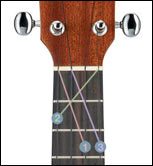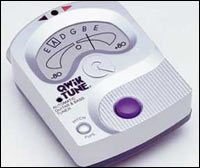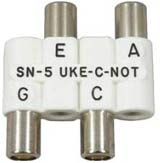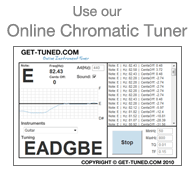How to Tune the Ukulele
| Ukulele Tunings | ||
| Type | Standard Tuning | Alternate Tunings |
| Soprano | G4-C4-E4-A4 | A4-D4-F#4-B4 G3-D4-A4-E4 |
| Concert | G4-C4-E4-A4 | A4-D4-F#4-B4 C3-G3-D4-A4 |
| Tenor | G4-C4-E4-A4 | G3-C4-E4-A4 D3-G3-B3-E4 |
| Baritone | D3-G3-B3-E4 | G4-C4-E4-A4 |
The four main types of ukulele (soprano, concert, tenor and baritone) each have their own standard tuning. However, it has become more common for the three smallest types of ukulele to all be tuned to G-C-E-A. While the standard tuning of the soprano ukulele is A4-D4-F#4-B4, it is now almost exclusively tuned down to the 'concert' tuning of G4-C4-E4-A4. The tenor on the other hand has two common G-C-E-A tunings, involving either a high-G or low-G. While the high-G tenor tuning is exactly the same as the concert and soprano tuning (G4-C4-E4-A4), the low-G tuning breaks away from the standard ukulele re-entrant tuning by lowering the G-string by an octave (G3-C4-E4-A4). The baritone ukulele is the most differently tuned of the four types of ukulele, as it is tuned to the same pitch as the four-highest strings of the guitar, with the scientific pitch: D3-G3-B3-E4.
- Tuning the Ukulele
- Ukulele Tuning Methods
- How to Tune a Baritone Ukulele
- Alternate Ukulele Tunings
- Tuning other Ukulele Types
- Common Ukulele Tuning Problems
- Quick-Reference Tuning Tips
The standard G4-C4-E4-A4 tuning of the ukulele is different from most other stringed instruments as the strings are not tuned from highest to lowest. Instead, the lowest string (the C-string) is placed in the middle of the higher-pitched G-string and E-string. This tuning is known as re-entrant tuning, and it is a feature that adds to the unique personality of the ukulele. You may have heard this tuning referred to as the 'My Dog Has Fleas' tuning, which is simply a little ditty that is commonly used to help players memorise the pitches of the ukulele strings in relation to one another.
| Standard Ukulele Tuning - A4(Hz):440 | ||||
| String | Scientific pitch | Helmholtz pitch | Semitones from Middle C | Frequency (Hz) |
| G | G4 | g′ | 7 | 392.00 |
| C | C4 | c′ | 0 | 261.63 |
| E | E4 | e′ | 4 | 329.63 |
| A | A4 | a′ | 9 | 440.00 |
The strings of the ukulele are tightened or loosened to produce the right note by the tuners (otherwise known as tuning pegs or pegs) which are located in the head of the ukulele, with pegs either to the side or pointing backwards. Most tuners have small gears attached to them to make turning the tuner smoother and easier, although tuning set-ups on cheap models of ukulele are known to slip very easily, causing the ukulele to go out of tune.
If you are just beginning to tune your ukulele, then it is a good idea to use a chromatic tuner to start off with. Chromatic tuners register the sound you are playing, and let you know if the note you have played is too sharp or too flat. If you have a microphone for your computer, or your computer has an in-built microphone, then you can use our Chromatic Instrument Tuner. Once you start to become familiar with the standard pitch of the ukulele strings (or if you already feel that you have a good ear), you may like to progress on to using a tuner that plays a note. To tune with a tuner that plays a note, you simply try to match the sound of your string to the reference note by turning the tuning peg higher or lower as needed. Check out our Online Ukulele Tuner to give it a go with your ukulele!
If you would like to know more about the scientific side of tuning, head over to The Science of Tuning Musical Instruments article.
Tuning the Ukulele
When tuning any instrument, you should always tune from below the note, up. This prevents string breakages and over-stretching the string. Tuning from below the note also helps to systematize the process of tuning, so you eventually become more familiar with the sound of a perfectly in-tune string. If you finish tuning your ukulele by lowering the string, then your string will often fall flat quicker. This is because when you loosen strings, leftover slack in the string often remains behind the nut and is released as you pluck and strum. To remedy this, play a few chords after you have tuned with a hard strum or stretch the strings out a little at the nut to release any slack that may have built up, then check the tuning of your ukulele again.
When you are tuning your ukulele, it helps to pluck the string with the same finger (or with your thumb) every time you check the pitch of the string so that the sound that you hear remains consistent. Let the note ring after you have plucked the string as this will help you to hear the note better. If your strings are new, you may need to tune very frequently while the strings get used to being stretched. This may mean that you have to stop and tune part-way through playing; and it is very possible you may even need to re-tune more than once during a practice.
The ukulele can be tuned using various different methods. You can tune a ukulele using a tuner, a piano, pitch pipes, or you can tune the ukulele to itself. Whatever way your chose to tune your ukulele, it is always best to unwind the string at least half a turn before you tune to prevent the string from being overstretched. Down-tuning like this will also help your ear to register when the pitch of the string is back in-tune. This rule applies any way you tune the ukulele - whether you are using a tuner that picks up the sound of your ukulele, or if you are tuning to a sounded note.
Whatever way you chose to tune, it is advisable to start by tuning the C string first, followed by the E string, then the G and A. Tuning your strings in order from highest-pitch to lowest-pitch helps you to recognise the distance in pitch between one string and another. Also, the 'C4' note itself is a great reference pitch to memorise - you may know it by its more common name; 'middle C'.
It helps to make several passes with each of the strings when you tune. Strings stretch, and often by the time you have finished tuning your instrument the first string you tuned will be out by a little bit (especially if your strings were well out-of-tune to begin with). Also, the increasing or decreasing tension on the strings when you tune them can make the body of the ukulele bend very slightly. This is completely normal, but may cause the strings to change slightly in pitch as you are tuning. Making two or three passes on your strings when you tune will help with this. Strings that are tuned precisely also tend to stay in tune for longer, so it is very worth putting that little bit of extra effort in when tuning to make sure that your tuning is as precise as you can make it.
Ukulele Tuning Methods
Tuning a Ukulele using a Piano
You can use a keyboard or piano to tune each individual string to a specific note on the piano. An easy and quick way for beginners. |
Tuning a Ukulele to Itself
Learn to tune the ukulele to itself using non-adjacent strings as references. Similar to the 5-4-5 fret method but this one has more accurate reference notes if the ukulele's frets aren't in perfect position. |
Tuning a Ukulele with Electronic Tuners
Tuning with an Electronic tuner is an easy task. Just twang your string and turn the pegs until it matches with the corresponding note. |
Tuning a Ukulele using Pitch Pipes
Learn how to tune a ukulele using pitch pipes. Pitch Pipes produce a sound when blown into, and you tune your ukulele to match the pitch. |
How to Tune a Baritone Ukulele
Read the full article: How to Tune a Baritone Ukulele
Baritone ukuleles are a little bit like the black sheep of the ukulele family, as they are tuned so differently. If you pick up a baritone ukulele, often it can be very frustrating finding the right advice and the right resources to help you learn to tune it as the vast majority of ukulele stuff is designed with GCEA tuning in mind. The baritone ukulele has the tuning of: D3-G3-B3-E4. Visit our How to Tune a Baritone Ukulele to learn more about tuning the baritone ukulele.
Alternate Ukulele Tunings
Read the full article: Alternate Ukulele Tunings
There are several different alternative tunings that are commonly used on the soprano, concert, tenor and baritone ukuleles. It is probable that you will come across music that uses these alternative tunings if you play one of these ukulele types; so it is good to become familiar with alternate tunings even if you are not planning on using them yourself anytime soon. Visit our Alternate Ukulele Tunings article to learn about it.
Tuning other Ukulele Types
Read the full article: Tuning Ukulele Variants
Some of the other less common kinds of ukulele have different standard-tuning to the basic four types of uke. This is particularly true for the kinds of ukulele that have additional strings, like the guitar ukulele (guitalele) and the 8-string ukulele. Some four-string types of ukulele also require different tuning, especially those ukuleles that fill different tonal roles to the standard ukulele types. The bass ukulele and the sopranino/piccolo uke both have different standard tuning as they fill different tonal roles to the G4-C4-E4-A4 standard-tuned ukulele. Visit our Tuning Ukulele Variants article to learn about the different tunings of a few of the most popular ukulele types.
Common Ukulele Tuning Problems
As low-end ukuleles are produced very cheaply, many of these models are plagued by manufacturing faults that cause issues with the tuning of the ukulele. Some of these problems can be fixed, while others unfortunately require replacement parts, or a replacement instrument. When you go to purchase a ukulele it pays to keep this in mind as usually a few simple checks in-store will let you know whether or not you will have trouble with the tuning of the ukulele. If in doubt, always ask the music retailer specifically whether or not they have experienced any problems with the tuning of the specific model you are looking at. Ask specifically about the fretting of the model too, as inaccurate fretting can't be fixed.
If you find that your ukulele slips out of tune easily, it could be due to several different reasons. Usually with new strings, you will find that they stretch out over a period of a few days. In this case, it's just a matter of playing out the slack in the new strings. However, if you start with your strings at a higher tension and tune down to the right note at the start of your practice, then it is possible that slack has built up behind the nut, which is then released as you pick or strum away at the strings. Check that this is not the case first, by stretching the strings out from the nut and then tuning back up to the correct note. If you don't think that your tuning is the problem, then it may be that your tuning peg is slipping. Most ukuleles have a machine-style tuning head, with a gear attached. Make sure that all the screws attached to the tuning peg/heads are tight (using a small screwdriver, tighten in small increments being careful not to over-tighten the screws) and check to see if this makes a difference. If not, it is probable that you will need to buy some better quality tuners.
If you are finding that your ukulele seems to just not sound quite right, especially on the higher frets (closer to the body of the ukulele) then you may have a fretting problem. Fretting problems are quite common on cheaper models of ukulele, and can make it sound like you are playing out-of-tune. Unfortunately, there's not much you can do to fix inaccurate fretting, so it is always best to check to see if an instrument is fretted well before you buy it.
Quick-Reference Tuning Tips
Tuning a ukulele is easy if you follow these simple tips:
-
Top Tip: Remember to always tune from below the note to prevent strings from over-stretching or even breaking.
-
Tune the C string first, followed by the E, G then A string. Tuning from low to high like this helps you to hear the pitch of the string. Alternatively you may like to tune using the 'My dog has fleas' ditty, if you find that helps you memorise the pitches of the strings better.
-
If you are using a tuner that sounds a note like our Online Ukulele Tuner, then try humming the right note from the tuner before you tune, so you know exactly what note you are looking for. If you can't reach the note with your voice, then just visualise humming it. This process has the effect of tuning in your brain and ears so they are on the same page.
-
Flex the string at the nut after tuning and then re-tune for the most accurate tuning result. Stretching slack out of the string will also help your strings remain in tune longer, so long as your tuning head itself isn't prone to slipping.














Mr Jhon
2014
April 3
age 9
rosey vlometed on the floor and in school
Mrs amilia
March 6
2014
age 8
theacher clatoyn
i always play with my ukelele evry day when my teacher told me to bring them
fdxf
rrrrrrrrrrrrrrrrrrrrrrrrrrrrrrrr ew
fdxf
rfrftrf56
GCEA
I may be wrong, but I believe the strings go from top to bottom, for a right handed player, just like this:
G (Top string)
C
E
A (Bottom string)
Lefties, reverse the order.
And if I am wrong, someone please correct me!
Tuning my Uke
I'm grateful for the information but like others, your delivery is lacking. I suspect the range of your audience includes many new to the uke along with those wanting to perfect their tunes. I suspect many readers just want advice on what method is best for their particular type.
I've noticed that most instruments include electronic tuners. These devices make it easy to tune string instruments and can be purchased for around $10 USD. Until recently I thought they were the only way to go. I now know they aren't all the same. Your article has helped me understand my previous assumptions were wrong. Unfortunately, I will need to read it a few more times before I'll be comfortable knowing my Uke is in tune.
I really liked your graphic explanation of "using non-adjacent strings." I knew about the 5-4-5-5 method from guitar playing but will be using your open string with the 2-.-3-3 for quick confirmations.
I agree strongly with your top tip of tuning from a lower note up to the correct note although another line to explain why might help.
I had never thought about tuning the C string first but it makes so much sense.
My recent purchase was an electronic tuner that allows me to choose either neck vibrations or microphone. Trouble is, my E string isn't consistent. :(
It also allows me to change from 430Hz - 450Hz. I don't know why or what is correct yet. I just want the track with my Uke strings to be in tune with my keyboard track.
Thanks again.
Bill
BillP Studios
It doesn't work
I was asking how do you make the ukulele note to c4 because mine says c3 and yall wouldn't help me.
I'm a bit confused about what you say in line two of paragraph four in the section "Tuning the Ukuele." There it is written: "Tuning your strings in order from highest-pitch to lowest-pitch helps you to recognise the distance in pitch between one string and another." Shouldn't this read, "Tuning your strings in order from LOWEST-pitch to HIGHEST-pitch, as the order you describe is C-E-G-A?
I found your information very helpful. Thanks.
Guitar
It helped me to know the srtings name parts and fun tions of guitar.
Tuning guitars
Tuning is very important for beginners. I think your information is bit confusing. Without tuning it is very hard. Right now i feel very hard of playing guitar and it is tuning.
On this web site it would help me, as a begin or to show a picture of which string is the CEG and a
tuning for beginners
Tuning is very important for beginners . but i think when you will buy ukulele that time you also need to know how to Tuning ukulele . There are many ways to tuning . you can chose any one for you .
Thanks for the great info on the page.
My reference sound will be a tuning fork(A 440Hz). Your page does not cover this directly. I managed to gather enough info from the different pages in order to start getting my ukulele in tune, but it would nice if you'd also cover a tuning method when A string is the starting point.
Thank You!
Very Much !
I had my boyfriend tune my ukulele and now the tension of the strings are very loose and it doesn't sound as clean or as nice, he went down a fair amount before tightening and tuning them again. How do I fix this problem? I have been looking online for days and no one has the answer. Please help me.
All very well but which string is which In a standard tune G is 1st presummably? i.e. the string at the bottom for a right handed player? Therefore A is the top string or 4th string?
In case you like to collect ukulele gear, there is a terrific new
plastic attachment Chord Changer on the market. It has 8 chord
buttons (yes!) Its great for introducing young children to music and the uke, as well as older folks with reduced fine motor skills, and college kids have them also. No lessons needed! The uke songbook with it
has 90 fun and memorable songs from many countries...a real treasury for all ages and occasions. Website is: ukechordchanger.com
A lot of good info here, thank you.